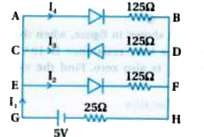The number density of electron is 7×1012m−3 and number density of hole is 7×1012m−3. This semiconductor will be ….. Type. Solution in Gujrati
p
n
intrinsic
p and n both type
The correct Answer is:C
intrinsic
In intrinsic semiconductor number density of electron and hole is equal, ne=nh=7×1012m−3
Topper's Solved these Questions
- BOOK - KUMAR PRAKASHANCHAPTER - SEMICONDUCTOR ELECTRONICS : MATERIALS, DEVICES AND SIMPLE CIRCUITS EXERCISE - Section-D : Multiple Choice Questions (MCQs) (MCQs asked in Competitive Exams)129videos
SEMICONDUCTOR ELECTRONICS : MATERIALS, DEVICES AND SIMPLE CIRCUITS
- BOOK - KUMAR PRAKASHANCHAPTER - SEMICONDUCTOR ELECTRONICS : MATERIALS, DEVICES AND SIMPLE CIRCUITS EXERCISE - Section-C: NCERT Exemplar Solution (Long Answer Type Questions)10videos
SEMICONDUCTOR ELECTRONICS : MATERIALS, DEVICES AND SIMPLE CIRCUITS
- BOOK - KUMAR PRAKASHANCHAPTER - SAMPLE QUESTION PAPER EXERCISE - PART-B SECTION-C5videos
SAMPLE QUESTION PAPER
- BOOK - KUMAR PRAKASHANCHAPTER - WAVE OPTICSEXERCISE - SECTION-D (MULTIPLCE CHOICE QUESTIONS (MCQS)) (MCQS FROM DARPAN BASED ON TEXTBOOK)239videos
WAVE OPTICS
Similar Questions
At absolute zero temperature Si acts as ……..
02:50View Solution
If each diode in figure has a forward bias resistance of 25Ω and infinite resistance in reverse bias, what will be the values of the current I1,I2,I3andI4?02:31View SolutionTwo charges –q and +q are located at points (0, 0, –a) and (0, 0, a), respectively.
(a) What is the electrostatic potential at the points (0, 0, z) and (x, y, 0) ?
(b) Obtain the dependence of potential on the distance r of a point from the origin when r/a>>1 .
(c) How much work is done in moving a small test charge from the point (5,0,0) to (–7,0,0) along the x-axis? Does the answer change if the path of the test charge between the same points is not along the x-axis?01:45View SolutionAccording to particle theory of light what is the velocity of light in a dense medium, compared to that in rare medium ?
01:39View SolutionA semiconductor has equal electron and hole concentration of 6xx 10^(4)m^(-3) . On doping with a certain impurity, electron concentration increases to 8 xx 10^(12)m^(-3) . Identify the type of semiconductor.
View SolutionA semiconductor has equal electron and hole concertration 6xx10^(8) m^(-3) . On doping with a certain impurity electron concertration increase to 8xx10^(12) m^(-3) . Identify the type of semiconductor after doping.
01:40View SolutionThe number density of free electrons in the semiconductor is 1018m−3. It is doped with a pentavalent impurity atoms of number density 1024m−3, the number density of free electrons m−3 increases by a factor of
02:54View Solutionएक अर्द्धचालक में इलेक्ट्रॉनों का सान्द्रता घनत्व 8×1014 प्रति सेमी^(3) है व होलों का सान्द्रता घनत्व 5×1012 प्रति सेमी^(3) है। यह अर्द्धचालक है :
02:25View SolutionIn an intrinsic semiconductor, the density of conduction electrons is 7.07×1015m−3 . When it is doped with indium, the density of holes becomes 5×1022m−3. Find the density of conduction electron is doped semiconductor
01:25View Solutionएक अर्द्धचालक का इलेक्ट्रॉन घनत्व 8×1014/सेमी3 तथा होल घनत्व 5×1012सेमी3 है। अर्द्धचालक है
01:19View SolutionThe number density of free electrons in the semiconductor is 10^(18) m^(-3) . It is doped with a pentavalent impurity atoms of number density 10^(24) m^(-3) . The number density of free electrons m^(-3) increases by a factor of
View SolutionElectron density of a semiconductor 0.45xx10^(12)//m^(3) And hole density 5xx10^(20)//m^(3) is. Its conductivity when the electron mobility =0.135m^(2)//Vs , Hole dynamics =0.048m^(2)//Vs And e=1.6xx10^(-19)C is.
03:28View SolutionThe ratio of number density of free electron and hole in p-type semiconductor is …….
02:19View SolutionThe number density of electron is 4.5×1022m−3 and number density of holes is 4.5×109m−3. This semiconductor is ………..
02:22View SolutionThe number densities of electrons and holes in pure Si at 27∘C is 2×1016m−3. When it is doped with indium, the hole density increases to 4×1022m−3, find the electron density in doped sillicon.
02:21View Solution

